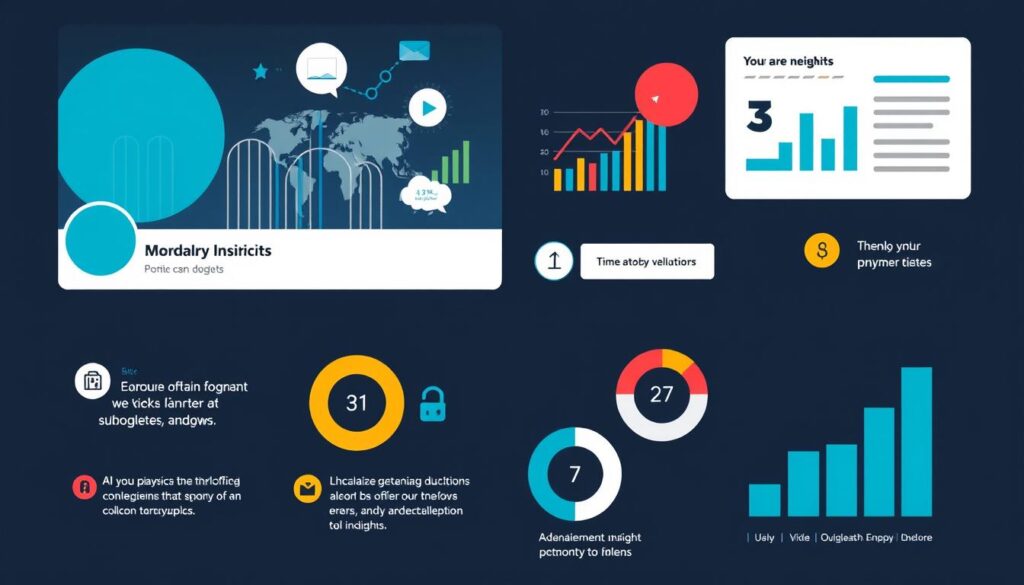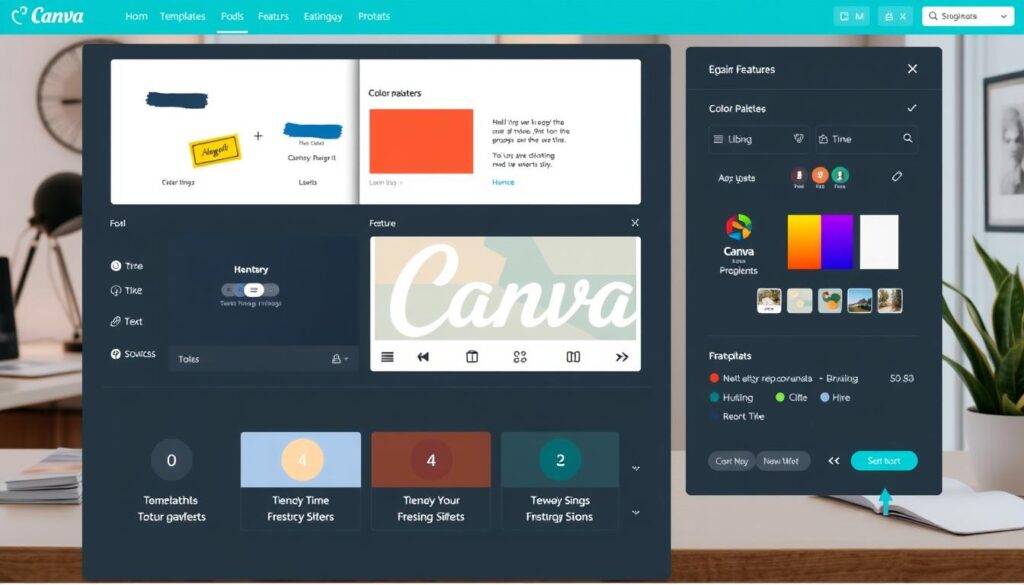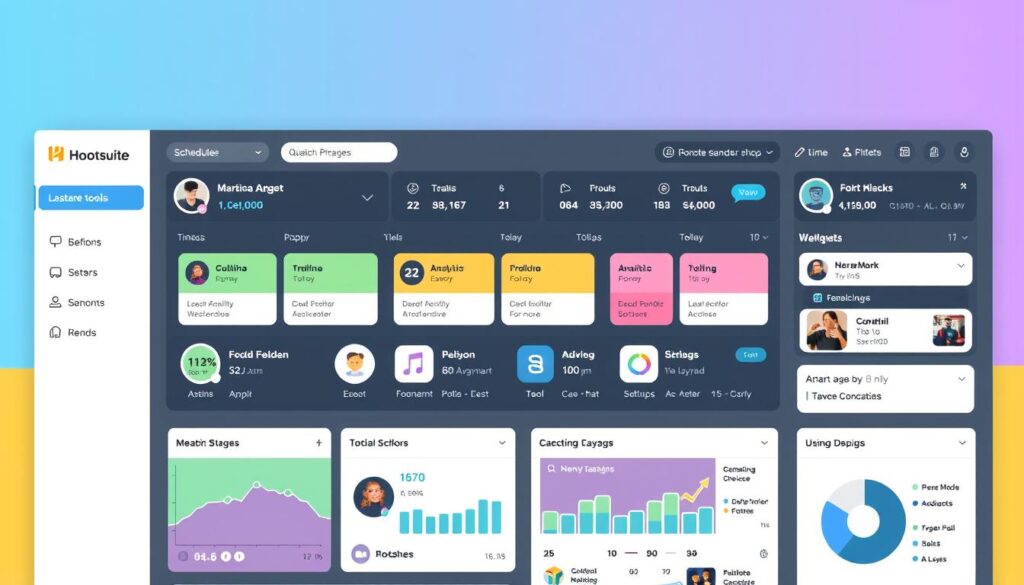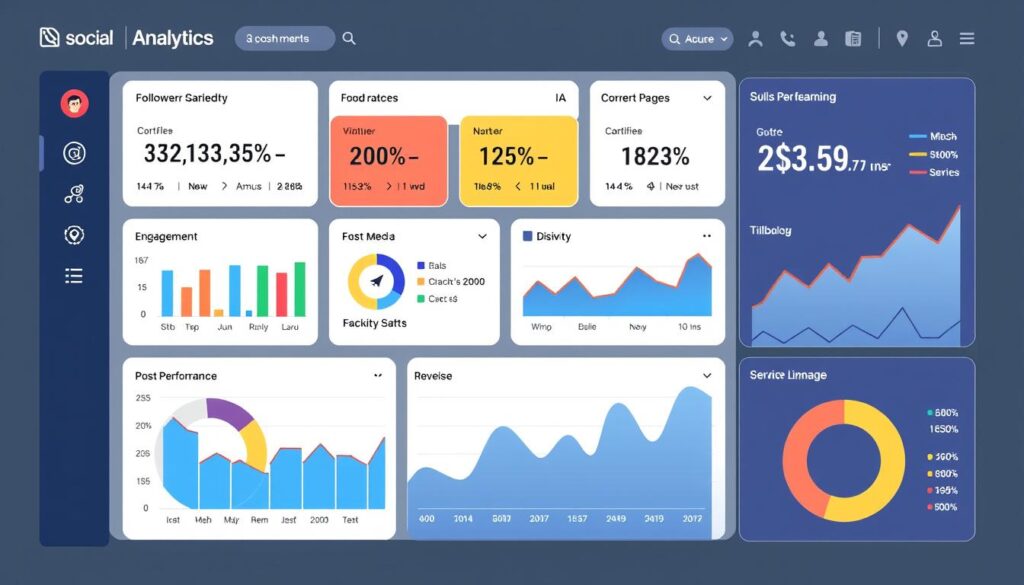In today’s digital landscape, crafting engaging posts, videos, graphics, and other forms of media is crucial for a brand’s online presence. Effective content creation on social media platforms like Instagram, X (formerly Twitter), LinkedIn, and TikTok helps build meaningful connections between brands and their followers.
With over 4.95 billion social media users worldwide, collectively spending close to 12 billion hours on these platforms daily, the importance of delivering value through content cannot be overstated. As noted in our recent article on social media content creation, 86% of consumers cite authenticity as a key factor when deciding what brands they like and support.
We’ll explore how strategic content creation can transform your brand’s online presence and boost engagement with your target audience.
Key Takeaways
- Crafting engaging content is crucial for a brand’s online presence.
- Effective content creation helps build meaningful connections with the audience.
- Authenticity is key to gaining consumer trust and support.
- Strategic content creation can significantly boost engagement.
- Understanding your audience is essential for delivering value through content.
Understanding Social Media Content Creation
In today’s digital landscape, understanding social media content creation is crucial for brands looking to boost their online presence. Social media has become an integral part of our daily lives, and businesses are continually seeking ways to leverage these platforms to reach their target audience effectively.
Effective social media content creation involves several key elements. As highlighted in our analysis, these include creativity, strategy, consistency, engaging visuals, and data-driven decisions. By incorporating these elements, brands can craft content that resonates with their audience and drives meaningful interactions.
Defining Social Media Content Creation
Social media content creation is more than just posting updates; it’s a strategic process of crafting platform-specific content that resonates with your target audience. It involves understanding your audience’s interests, challenges, and behaviors to create content that is both relevant and engaging. As we explore the fundamentals of social media content creation, it’s clear that creativity and strategy are at the forefront of this process.

The Importance of Content Creation for Your Brand
Content creation serves as the foundation of your entire social media presence, acting as the primary way your brand communicates with potential and existing customers. Quality content matters more than quantity in building a strong brand presence, directly impacting your audience’s perception of your business. By focusing on thoughtful content creation, brands can achieve tangible business outcomes such as increased brand awareness, higher engagement rates, and ultimately, conversions and sales.
As noted by industry experts, “Content is the atomic particle of all digital marketing.” This emphasizes the critical role that content plays in digital marketing strategies. By understanding and implementing effective social media content creation practices, brands can significantly enhance their online presence and achieve their marketing goals.
The Psychology Behind Engaging Social Media Content
Creating engaging social media content requires a deep dive into the psychological factors that influence user behavior. Social media thrives on innovation, and experimenting with different content formats is crucial to keeping your strategy fresh.
Each platform offers unique opportunities to engage your audience in creative ways. By testing new formats, you can uncover what resonates best with your audience and adapt your approach accordingly.
What Makes Content Shareable
Certain content is more likely to be shared due to psychological triggers such as emotional responses, perceived value, and social currency. Understanding these triggers can help you craft content that encourages engagement and sharing.
For instance, content that evokes emotions like joy or surprise is more likely to be shared. Similarly, content that provides valuable information or insights is perceived as useful and shared among users.
Understanding Your Audience’s Content Preferences
Different content formats appeal to different psychological needs and preferences. By understanding your audience’s preferences, you can tailor your content to match their expectations, thereby increasing engagement.

Using social media analytics to track performance and metrics like views, shares, and engagement rates can provide insights into what works best for your audience.
Essential Types of Social Media Content
To effectively engage your audience on social media, it’s crucial to understand the diverse range of content types that perform well across various platforms. Social media content comes in various forms, each serving a unique purpose to engage, educate, and convert your audience.
The top types of social media content include images, which are visually engaging and ideal for grabbing attention; videos, which are highly effective for social media storytelling; infographics, which simplify complex data into visually appealing visuals; User-Generated Content (UGC), which is unfiltered and authentic, helping build trust; and polls and surveys, which offer real-time engagement and valuable insights into audience preferences.
Images and Graphics
Images are a crucial element of social media content, capable of capturing attention quickly and communicating your message effectively when designed with your audience in mind. Static images and graphics can be used to share information, showcase products, or simply add visual appeal to your posts.
Videos and Live Streams
Videos have become increasingly important in social media content strategies, offering a dynamic way to capture emotions and convey information. From polished productions to authentic live streams, video content serves different engagement purposes and can be tailored to various audience preferences.
Stories and Ephemeral Content
Stories and other forms of ephemeral content create a sense of urgency and authenticity, encouraging more frequent and casual engagement from your audience. This type of content is particularly effective for behind-the-scenes insights, sneak peeks, and exclusive offers.
User-Generated Content
User-Generated Content (UGC) is a powerful trust-building tool that showcases real customer experiences with your brand. By encouraging and sharing UGC, you can foster a sense of community and social proof around your brand.
Polls, Quizzes, and Interactive Content
Polls, quizzes, and other interactive content formats actively involve your audience and provide valuable insights into their preferences and opinions. These tools can be used to spark conversations, gather feedback, and enhance engagement.
Social Media Content Creation Process
Developing a social media content strategy that resonates with your audience requires a systematic approach, beginning with audience research. Great content starts with a clear understanding of your audience, a focus on data, and a consistent approach to execution.
Researching Your Target Audience
The first step to creating resonant content is understanding who you’re talking to. We define our audience personas based on their interests, pain points, and behaviors. This helps us craft messages that truly connect with our target audience.
Finding Content Gaps in Your Industry
Looking at your competitors and identifying what’s missing from their social media content strategy is crucial. We examine what their audiences are asking for that they aren’t delivering. Filling these gaps positions us as a go-to resource in our industry.
Setting Clear Content Goals
All of our business and marketing initiatives need goals to help us measure performance. A few goals we can have for our social media strategy include brand awareness, website traffic, sales and lead generation, and engagement. We outline the process of setting SMART (Specific, Measurable, Achievable, Relevant, Time-bound) content goals that align with our broader business objectives.
By following this systematic approach, we can create effective social media content that resonates with our audience and drives results. Understanding our audience and identifying content gaps are key to developing a successful content strategy.
Developing Your Content Strategy
A well-crafted content strategy serves as the backbone of your social media activities, guiding your content creation efforts. It helps in organizing your content around key themes, ensuring consistency, and engaging your audience effectively.
Creating Content Pillars
Content pillars are the core themes around which your content is structured. For instance, a beauty brand might focus on behind-the-scenes content, educational content like makeup tutorials, and conversational content such as community stories. Establishing 3-5 content pillars helps in maintaining consistency in your messaging and organizing your content effectively.
Balancing Promotional and Value-Adding Content
It’s crucial to strike a balance between promotional content and value-adding content. Following the 80/20 rule, where 80% of your content adds value and 20% is promotional, can help keep your audience engaged without overwhelming them with sales pitches.
| Content Type | Description | Example |
|---|---|---|
| Promotional Content | Content aimed at promoting products or services. | Product launch announcements |
| Value-Adding Content | Content that educates, entertains, or informs the audience. | Tutorials, industry insights |
Maintaining Brand Voice Across Platforms
Maintaining a consistent brand voice across different social media platforms is vital. Your brand voice should reflect your company’s personality while adapting to the nuances of each platform. This consistency helps in building a strong brand identity and fostering a loyal community.
Content Planning and Organization
Streamlining your content creation process starts with a robust planning and organization strategy. By doing so, we can save time, reduce stress, and maintain a consistent posting schedule across all our social media channels. Proper content planning and organization enable us to align our content with our marketing goals, seasonal events, and product launches.
Building an Effective Content Calendar
Creating a content calendar is a crucial step in planning our social media content ahead of time. This tool helps us schedule posts on all our platforms from one place, ensuring consistency and efficiency. By using a social media management platform, we can track the effectiveness of our posts and analyze different aspects of our marketing strategy to make improvements in real-time. To build an effective content calendar, we should consider our marketing goals, the type of content that performs well on each platform, and any upcoming events or product launches.
When creating our content calendar, we can use templates or tools that streamline the planning process and make collaboration easier. This allows us to visualize our content strategy and make adjustments as needed.
Content Batching Techniques
Another effective strategy for content planning is content batching. This involves creating multiple pieces of content in one sitting, maximizing our productivity while maintaining quality. By batching similar tasks together, such as writing captions or designing graphics, we can work more efficiently and reduce the time spent switching between tasks.
To implement content batching, we can dedicate specific days to creating different types of content. For example, we might spend one day writing and scheduling all our social media posts for the week, and another day creating graphics and videos. This approach helps us stay organized and ensures that our content is consistent across all platforms.
By combining an effective content calendar with content batching techniques, we can optimize our content creation process, saving time and improving our overall social media strategy.
Platform-Specific Content Creation
The key to successful social media content lies in adapting to the specific culture and expectations of each platform. Each social media marketing platform has its own purpose and strength, and tailoring your content to match the platform’s vibe and audience preferences is crucial to becoming the algorithm’s favorite.
Instagram Content Strategies
Instagram is a visually-driven platform where trends come and go quickly. To create engaging content, focus on high-quality visuals and utilize trending audios for Reels.

Facebook Content Best Practices
Facebook’s diverse content ecosystem requires a strategic approach. To generate meaningful engagement, create posts that are informative, entertaining, or interactive.

LinkedIn Content Optimization
On LinkedIn, establishing thought leadership and building business relationships is key. Optimize your content by using relevant keywords, providing valuable insights, and engaging with your audience.

TikTok and Short-Form Video Content
TikTok’s short-form video culture thrives on authenticity and trend-driven content. To succeed, create short videos that are engaging, creative, and relevant to current trends.

By understanding the unique characteristics of each social media platform and adapting your content strategies and practices accordingly, you can maximize your online presence and engagement.
Creating Compelling Visual Content
In today’s fast-scrolling social media environment, capturing attention is crucial, and high-quality visual content is key to achieving this. Visual elements such as images and videos not only grab users’ attention but also significantly enhance engagement and brand recall.
To create effective visual content, understanding the principles behind it is essential. Let’s dive into the fundamental aspects that make visual content compelling.
Design Principles for Social Media Graphics
When designing graphics for social media, several key principles come into play. Color theory is crucial as it can evoke emotions and convey your brand’s message. Choosing a palette that aligns with your brand identity is vital. Typography is another important aspect; selecting fonts that are clear, readable, and consistent with your brand voice can make a significant difference.
- Use contrasting colors to make your text stand out.
- Keep your design simple and focused on the key message.
- Ensure your graphics are optimized for different social media platforms.
Video Production Tips for Non-Professionals
Creating high-quality videos doesn’t require professional equipment; a smartphone and basic editing apps can suffice. The key is to focus on storytelling and authenticity. Start with a clear concept and ensure your video has a concise, engaging narrative.
- Plan your content and storyboard before you start filming.
- Use good lighting and sound quality to enhance the viewing experience.
- Edit your video to keep it concise and engaging.
By applying these principles and tips, you can create compelling visual content that resonates with your audience and elevates your social media presence.
Writing Engaging Copy for Social Media
Crafting compelling social media copy is an art that requires a deep understanding of your audience and the platform you’re using. Your message needs to grab attention and solve a problem for your audience. As noted by a social media expert, “Writing social media content is a matter of figuring out what is the main message of your post, and saying it in a way that will make people read until the end.“
Crafting Attention-Grabbing Headlines
The first step in writing engaging social media copy is to craft attention-grabbing headlines. Your headline should be clear, concise, and compelling, making your audience want to read more. To achieve this, use strong verbs and focus on the benefits that your content provides. For instance, using action-oriented language can significantly improve engagement.
Effective Calls-to-Action
Every piece of social media content should prompt your audience to take meaningful action, such as clicking a link, leaving a comment, or making a purchase. To create effective calls-to-action, use formulas and frameworks that motivate your audience to take the next step. As an example, “Join the conversation by sharing your thoughts in the comments below” can encourage engagement and foster a sense of community.
By balancing brevity and substance in your social media writing, you can communicate your message clearly without losing impact. With the help of AI-powered content creation tools, you can ideate, optimize, and localize content according to platform specifications, content goals, and audience preferences.
5 Advanced Strategies for Boosting Social Media Engagement
Elevating your brand’s social media engagement involves leveraging cutting-edge strategies that not only capture attention but also encourage active participation. As we continue to navigate the ever-changing landscape of social media, it’s crucial to stay ahead of the curve and adopt innovative approaches that resonate with our audience.
Leveraging Trending Topics and Events
Staying on top of trending topics and events is vital for making your content relevant and timely. Platforms like TikTok are breeding grounds for new trends, and being among the first to adapt these trends to your brand’s voice can be a significant advantage. By doing so, we can increase our content’s visibility and engagement.
Creating Themed Content Series
Developing themed content series is an effective way to keep our audience engaged over time. By creating a series around a specific theme, we can build anticipation and establish our brand as a consistent source of valuable content. This approach helps in fostering a deeper connection with our followers.
Implementing Social Media Contests and Giveaways
Social media contests are engaging and fun, encouraging participation and generating excitement around our brand. To implement a successful contest, we need to ensure that the entry process is straightforward and the prize is appealing. This strategy can lead to increased engagement and brand visibility.
Collaborating with Influencers and Partners
Collaborating with influencers and brand partners can significantly expand our reach and add credibility to our content. By choosing partners whose values align with ours, we can create authentic and engaging content that resonates with a broader audience.
Using Storytelling Techniques
Storytelling is a powerful tool for transforming ordinary content into compelling narratives that emotionally resonate with our audience. By incorporating storytelling techniques into our social media content, we can create a deeper, more meaningful connection with our followers.
To illustrate the effectiveness of these strategies, let’s examine a comparison of engagement metrics before and after implementation:
| Strategy | Pre-Implementation Engagement | Post-Implementation Engagement |
|---|---|---|
| Leveraging Trending Topics | 1000 likes | 5000 likes |
| Themed Content Series | 500 comments | 2000 comments |
| Social Media Contests | 200 shares | 1000 shares |
Tools and Resources for Social Media Content Creation
To elevate your social media game, leveraging the best content creation tools is essential. With the right tools and resources, you can streamline your content creation process, saving time and improving content quality.
Design and Editing Tools

Design and editing tools are crucial for creating visually appealing content. Canva is a popular choice among social media managers for its ease of use and extensive template library. Other notable mentions include Adobe Express and CapCut for video editing.
Content Planning and Scheduling Platforms

Content planning and scheduling platforms help maintain a consistent posting schedule across multiple channels. Tools like Hootsuite, Buffer, and Later allow you to plan, schedule, and publish content in advance, ensuring a cohesive content strategy.
Analytics and Performance Tracking

Understanding your content’s performance is vital for refining your strategy. Analytics tools provide insights into what resonates with your audience and areas for improvement. By leveraging these tools, you can make data-driven decisions to enhance your social media content creation.
By incorporating these tools and resources into your social media content creation process, you can significantly improve your content’s quality and engagement.
Measuring Content Performance
Measuring content performance is a vital step in refining your social media strategy and achieving your business goals. To ensure your social media content is effective, you need to track its performance regularly.
After posting content, it’s essential to re-evaluate it to determine which types of posts perform well and get the most engagement among your target audience. By keeping track of your likes, comments, and web traffic, you can identify the most effective types of content in your social media content plan.
Key Metrics to Track
To measure content performance, you need to track key metrics that align with your business goals. These may include engagement rates, impressions, conversions, and other relevant metrics. By monitoring these metrics, you can gain valuable insights into what works and what doesn’t.
- Engagement rates (likes, comments, shares)
- Impressions (views, reach)
- Conversions (sales, sign-ups, downloads)
Using Analytics to Refine Your Strategy
Using analytics tools, you can track engagement, impressions, and conversions, and make data-driven decisions about your content strategy. By analyzing your social media data, you can identify patterns and trends that reveal which formats, topics, or posting times deliver the best results.
By refining your strategy based on analytics insights, you can optimize your social media content to better resonate with your target audience and drive real business results.
Conclusion: Building a Sustainable Content Creation System
Building a sustainable content creation system is crucial for maintaining a strong social media presence. As we’ve discussed throughout this article, effective social media content creation involves understanding your audience, developing a clear strategy, and leveraging the right tools and techniques.
To achieve this, focus on creating efficient content creation processes through templates and workflows, and consider how to scale your content efforts as your business grows. By doing so, you’ll be able to maintain a consistent social media content stream without sacrificing quality or burning out your team.
By implementing these strategies and continually refining your approach based on performance data, you’ll be well on your way to creating a sustainable content creation system that drives real results for your business.






